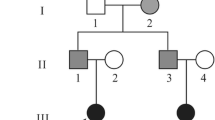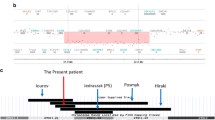Abstract
This is the report of two independent families in which a balanced maternal translocation led to trisomy 12p in one of each their offspring. Evaluation of 21 further case reports indicates that this is a phenotypically well defined syndrome which leads to severe developmental retardation. It can be recognized by a characteristic combination of craniofacial anomalies which are summarized in a phantom picture. The gene sequences which produce the typical features in the trisomic state must be localized distally to band 12p 12, which is the breakpoint in the partial trisomies. The specific craniofacial anomalies are not visibly modified by the length of the trisomic segment or additional small monosomies or trisomies of recipient chromosomes. However, the frequency and severity of organ malformations and the resulting probability of survival seem to decrease with increasing degrees of chromosomal imbalance. A cytogenetic classification of the 21 inherited translocations and a segregation analysis from the pedigree data was performed. For the different types of translocations the calculated risk figures are given.
Similar content being viewed by others
References
André MJ (1976) Etude cytogénetique d'un nouveau cas de trisomie 12p. Bull Assoc Anat (Nancy) 60:455–463
Armendares S, Salamanca F, Nava S, Ramirez S, Cantu JM (1975) The 12p trisomy syndrome. Ann Genet 18:89–94
Alfi O, Lange M (1976) Trisomy 12p, a clinically recognizable syndrome. Excerpta Medica, International Congress Series No. 397, pp 109–110
Biederman B, Bowen P, Robertson C, Schiff D (1977) Partial trisomy 12p due to t(12;21)pat translocation. Hum Genet 36:35–41
Bijlsma JB, de France HF, Blecker-Wagemakers LM, Bijkstra PF (1978) Double translocation t(7;12),t(2;6) heterozygosity in one family. Hum Genet 40:135–147
Carlin ME, Norman Ch (1978) Case report: partial trisomy 12p associated with 4p deletion due to paternal t(12p−;4p+) translocation. Birth defects Orig Art Series 14/6C, pp 399–404
Dutrillaux B, Lejeune J (1971) Sur une nouvelle technique d'analyse du caryotype humain. C.R. Acad Sci (Paris) D 272:2638–2640
Ford CE, Clegg HM (1970) Reciprocal translocations. Br Med Bull 25:110–114
Francke U (1980) Strategien bei der Analyse von Strukturanomalien. Paper, presented at the 7th cytogenetic meeting of the German Society of Anthropology and Human Genetics, Essen, FRG
Fryns JP, van den Berghe H, Van Herck G, Cassiman JJ (1974) Trisomy 12p due to familial t(12p−;6q+) translocation. Hum Genet 24:247–252
Grouchy J de, Turleau C (1977) Atlas des maladies chromosomiques. Expansion Scientifique Francaise, Paris
Hamerton JL, Mohandas T, McAlpine PJ, Douglas GR (1975) Localization of gene loci on chromosomes 12 and X in man. In: Bergsma D (ed) Human Gene Mapping 2, Rotterdam Conference (1974). Birth Defects: Original Article Series Vol XI: No. 3
Hansteen IL, Schirmer L, Hestetun S (1978) Trisomy 12p syndrome. Evaluation of a family with a t(12;21)(p12.1;p11) translocation with unbalanced offspring. Clin Genet 13:339–349
Kondo I, Hamaguchi H, Haneda T (1979) Trisomy 12p syndrome. De novo occurrence of mosaic trisomy 12p in a mentally retarded boy. Hum Genet 46:135–141
Lindenbaum RH, Bobrow M (1975) Reciprocal translocations in man. 3∶1 meiotic disjunction resulting in 47 or 45 chromosome offspring. J Med Genet 12:29–43
Niebuhr E (1978) The cri du chat syndrome. Epidemiology, cytogenetics and clinical features. Hum Genet 44 (3):227–276
Nielsen J, Vetner M, Holm V, Askjaer SA, Reske-Nielsen E (1977) A newborn child with karyotype 47,XX,+der(12) (12pter→12q12::8q24→8qter),t(8;12)(q24;q12)pat. Human Genet 35:357–362
Paris Conference (1971) Standardisation in human cytogenetics. Cytogenetics 11:315–362
Paris Conference (1975) Supplement (1975): Standardisation in human cytogenetics. Cytogenet Cell Genet 15:201–238
Parslow M, Chambers D, Drummond M, Hunter W (1979) Two cases of trisomy 12p due to rec t(12;21)(p11;p11) inherited through three generations. Hum Genet 47:253–260
Prieur M, Dutrillaux B, Lejeune J (1973) Planches descriptives des chromosomes humains (analyse en bandes R et nomenclature selon la conférence de Paris 1971). Ann Genet 16:39–46
Rethoré MO, Kaplan JC, Junien C, Cruveiller J, Dutrillaux B, Aurias A, Carpentier S, Lafourcade J, Lejeune J (1975) Augmentation de l'activité de la LDH-B chez un garçon trisomique 12p par malségregation d'une translocation maternelle t(12;14)(q12;p11). Ann Genet 18:81–87
Rethoré MO, Junien C, Malpuch G, Baccichetti C, Tenconi R, Kaplan JC, Romauf J de, Lejeune J (1976) Localisation du gène de la glyceraldéhyde 3-phosphate deshydrogénase (G3PD) sur le segment distal du bras court du chromosome 12. Ann Genet (Paris) 19:140–142
Rethoré MO, Kaplan JC, Junien C, Lejeune J (1977) 12pter→ 12p12.1: Possible assignement of human triose phosphate isomerase. Hum Genet 36:235–237
Savary JB, Cousin J, Lai JL, Deminatti M (1977) Trisomie partielle 12 et 8 en mosaique, avec translocation t(8;12) (p21;q13). Ann Genet 20:122–127
Schnedl W (1974) Banding patterns in human chromosomes. In: Schwarzacher H, Wolf U (eds) Methods in human cytogenetics, Springer Verlag
Serville F, Junien C, Kaplan JC, Gachet M, Cadoux J, Broustet A (1978) Gene dosage effect for human triosephosphate isomerase and glyceraldehyde-3-phosphate dehydrogenase in partial trisomy 12p 13 and trisomy 18p. Hum Genet 45:63–69
Stene J, Stengel-Rutkowski S (1981) Genetic risks for familial translocations with special emphasis on those giving birth to 9p, 10p and 12p trisomies (in preparation)
Suerinck E, Suerinck A, Kaplan JC, Meyer J, Junien C, Noel B, Rethoré MO (1978) Trisomy 12p par malségrégation d'une translocation paternelle t(12;22)(p11;p11). Ann Genet 21:243–246
Tenconi R, Piovan E, Preto A, Magnabosco R, Bacchichetti C (1977) Syndrome +12p. Hum Genet 39:97–101
Tenconi R, Giorgi PL, Tarantino E, Formica A (1978) Trisomy 12p to an adjacent 1 segregation of a maternal reciprocal translocation t(12;18)(p11;q23). Ann Genet 21:229–233
Uchida IA, Lin CC (1973) Identification of partial 12 trisomy by quinacrine fluorescence. J Pediatr 82:269–272
Walther JU, Stengel-Rutkowski S, Murken JD (1974) Observations with G-banding of human chromosomes. Reduction of dye concentration in Soerensen buffered solution is sufficient for demonstrating G-bands. Hum Genet 25:49–51
Author information
Authors and Affiliations
Rights and permissions
About this article
Cite this article
Stengel-Rutkowski, S., Albert, A., Murken, J.D. et al. New chromosomal dysmorphic syndromes. Eur J Pediatr 136, 249–262 (1981). https://doi.org/10.1007/BF00442992
Received:
Issue Date:
DOI: https://doi.org/10.1007/BF00442992




